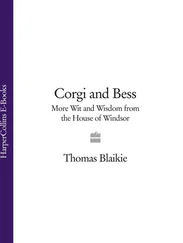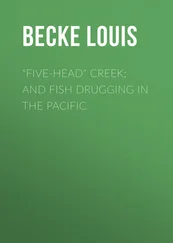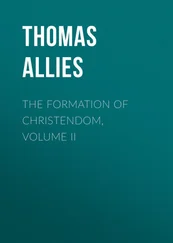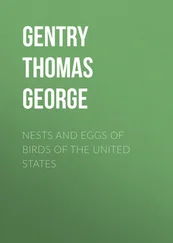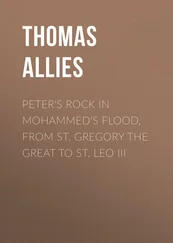Thomas Allies - Church and State as Seen in the Formation of Christendom
Здесь есть возможность читать онлайн «Thomas Allies - Church and State as Seen in the Formation of Christendom» — ознакомительный отрывок электронной книги совершенно бесплатно, а после прочтения отрывка купить полную версию. В некоторых случаях можно слушать аудио, скачать через торрент в формате fb2 и присутствует краткое содержание. ISBN: , Жанр: foreign_antique, foreign_prose, Историческая проза, на английском языке. Описание произведения, (предисловие) а так же отзывы посетителей доступны на портале библиотеки ЛибКат.
- Название:Church and State as Seen in the Formation of Christendom
- Автор:
- Жанр:
- Год:неизвестен
- ISBN:http://www.gutenberg.org/ebooks/38537
- Рейтинг книги:4 / 5. Голосов: 1
-
Избранное:Добавить в избранное
- Отзывы:
-
Ваша оценка:
- 80
- 1
- 2
- 3
- 4
- 5
Church and State as Seen in the Formation of Christendom: краткое содержание, описание и аннотация
Предлагаем к чтению аннотацию, описание, краткое содержание или предисловие (зависит от того, что написал сам автор книги «Church and State as Seen in the Formation of Christendom»). Если вы не нашли необходимую информацию о книге — напишите в комментариях, мы постараемся отыскать её.
Church and State as Seen in the Formation of Christendom — читать онлайн ознакомительный отрывок
Ниже представлен текст книги, разбитый по страницам. Система сохранения места последней прочитанной страницы, позволяет с удобством читать онлайн бесплатно книгу «Church and State as Seen in the Formation of Christendom», без необходимости каждый раз заново искать на чём Вы остановились. Поставьте закладку, и сможете в любой момент перейти на страницу, на которой закончили чтение.
Интервал:
Закладка:
This was an image and likeness which belonged to Adam in a double capacity, firstly, as an individual, secondly, as head of a family; for it was to descend to each individual of the family in virtue of natural procreation from Adam. The man created after the image and likeness of the Triune God was, according to the divine intention, to be repeated in every one of the race.
But what of the family or race which was to be evolved out of Adam alone? Not the individual only but the race also is in the divine plan. Is there a further image of the Triune God in the mode of the race’s formation?
To give an answer to this question, we must first consider what is the prototype of that singular unity according to which the first parents of the race are not formed together out of the earth, male and female, like the inferior creatures. For in most marked distinction from all these man is formed by himself, and alone; receives the command to eat of all trees in the garden except the tree of the knowledge of good and evil, under penalty of death if he take of it; and then is shown exercising the grandeur of his knowledge and the fulness of his royalty in the naming of the subject creatures. But inasmuch as none of them could supply him with a companion, and as “it was not good for him to be alone,” a council of the Triune God is held again, and a help like to himself is taken out of himself. Is there not here, with that infinite distance which separates the created from the Increate, a yet striking image of the Divine Filiation?
Again, from the conjunction of the two, from Adam the head, and from Eve when she has been drawn out of him, proceeds, in virtue of the blessing of God, the human family. Is there not here, again, at that distance which separates divine from human things, an image of the procession of the Third Divine Person, the Lord, and the Giver of life, from whom all life proceeds?
May we not then say with reverence, that from the council of the Triune God, “Let us make man to our image and likeness,” proceeds forth the individual man, an earthly counterpart in his memory, understanding, and will to the divine Creator, and likewise man, the family, a created image of the primal mystery, the ineffable joy of the Godhead, the ever blessed Trinity in Unity? And since the origin of creation itself is the free act of God, it ought not to surprise us that the chief work of His hands in the visible universe should reflect in the proportion of a creature the secret life of the Divine Nature, the Unity and Trinity of the Godhead.
But next to this primal mystery, which is the source of all creation, stands that unspeakable condescension, that act of sovereign goodness, by which God has chosen to assume a created nature into personal unity with Himself, and to crown the creation which He has made. As to this the first Adam, in all his headship, with the privileges included in it, the transmission to his family of original justice, and of that wonderful gift of adoption superadded to it, is “the figure of Him who was to come.” But more also, St. Paul tells us, is indicated in the formation of Eve out of Adam during the sleep divinely cast upon him. This was the “great sacrament of Christ and of His Church” (Eph. v. 32), to which he pointed in reminding his hearers of the high institution of Christian marriage. And thus we learn that God, in the act of forming the natural race, supernaturally endowed, was pleased to foreshadow by the building of Eve, “the mother of all living,” out of the first Adam, the building of another Eve, the second and truer mother of a divine race, out of the wounded heart of the Redeemer of the world asleep upon the cross. As then in Adam’s headship we have the figure of the Headship of Christ, so in the issuing of Eve from him in his sleep we have the Passion of Christ and the issuing forth of His Bride from it, when His work of redemption was completed and His royalty proclaimed.
Thus the mysteries of the blessed Trinity, that is, of God the Creator, and of the Incarnation and Passion of Christ, that is, of God the Redeemer, lie folded up, as it were, in the Mosaic narrative of the mode in which Adam was created, and in the headship of the race conferred upon him.
Before we approach the sin of Adam and its consequences to human society, let us cast one glance back upon the beauty and splendour of the divine plan in the original creation as it is disclosed to us in the narrative of Moses. As the crown of the visible creation is placed a being who is at once an individual and the head of a family, representing in his personal nature the divine Unity and Trinity, and in the race of which he is to stand at the head the same divine Unity and Trinity in their aspect towards creation; representing the royalty of God in his dominion over the creatures, a dominion the condition of which is the obedience of his own compound nature to the law given to it by the Creator; representing again in the vast number to which his race shall extend the prolific energy of the Lord of Hosts; representing also in that secret and altogether wonderful mystery, out of which the multiplication of his race springs, the yet untold secret of the divine mercy, in virtue of which his fathership is the prelude to a higher fathership, the first man is the pattern of the Second, and the royalty of his creation but a rehearsal at the beginning of the world of the reparation which is to crown its end.
The whole work of creation as above described, depends in its result upon the exercise of man’s free-will. His value, before God, lies simply in the way in which he exerts this great prerogative of his reasonable nature. Without it he would be reduced from one who chooses his course, and in that choice becomes good or evil, to the condition of a machine devoid of any moral being. To test this free-will man was given a commandment. We know that he failed under the trial; that he broke the commandment. His disobedience to his Creator was punished by the disobedience of his own compound nature to himself. That divine grace, which we term the state of original justice, and in virtue of which his soul, with its understanding and will, illuminated and fortified, was subject to God, and the body with all its appetites was subject to the soul, was withdrawn. He became subject to death, the certain death of the body, with all that train of diseases and pains which precede it; and the final separation of the soul from its Creator, unless by the way which God indicated to him he should be restored. Becoming a sinner, his refuge was penitence; henceforth his life was to be the life of a penitent; he had lost the grace which was bestowed royally on the innocent; he was left the grace which was to support and lead on the penitent. From the garden of pleasure he is expelled, to go forth into a world which produces thorns and thistles, unless he water it with the sweat of his brow. To all this I only allude, since my proper subject is to trace the first formation of human society as it came forth from the fall. But the primal state of man could not be passed over, because the state in which he grew up, and the state in which he now stands, cannot be understood nor estimated rightly without a due conception of that original condition.
With the loss of original justice Adam does not lose the headship of his race. All men that are to be born remain his children, and continue to be not a species of similar individuals, but a family, a race. All the dealings of God with them continue to be dealings with them as a race. Adam’s fathership, had he not fallen, would have been to them the source of an inestimable good, would have secured to them the transmission of original justice, crowned as it further was by a wholly gratuitous gift, the gift of adoption to a divine sonship. But that fathership, in consequence of his sin, actually transmitted to them a nature penally deprived both of the original endowment and of the superadded adoption; and, as a fact, all the difficulties which occur to the mind in the divine government of the world spring out of this treatment by God of man as a family, a race. But likewise through this continuing fathership of Adam, the Fathership of Christ appears as the completion of an original plan, devised before the foundation of the world, and actually carried out at the appointed time. He was to be son of David and son of Abraham in order that He might be Son of man. This original plan of God is not frustrated but executed by the fall of Adam. The yet undisclosed secrets of human lot have their origin in Adam and their solution in Christ. We are allowed to see that they belong to one plan. No doubt the hidden things of God in this dispensation baffle our scrutiny: they remain for the trial of faith until faith passes into sight, but we are allowed to see the fact of a vast compensation; and over against the fathership which brought death and corruption and the interminable ills of human life, we see all the supernatural blessings of the new covenant, consisting in the triple dowry of adoption, betrothal, and consecration, come to man as a spiritual race descending from the Second Adam.
Читать дальшеИнтервал:
Закладка:
Похожие книги на «Church and State as Seen in the Formation of Christendom»
Представляем Вашему вниманию похожие книги на «Church and State as Seen in the Formation of Christendom» списком для выбора. Мы отобрали схожую по названию и смыслу литературу в надежде предоставить читателям больше вариантов отыскать новые, интересные, ещё непрочитанные произведения.
Обсуждение, отзывы о книге «Church and State as Seen in the Formation of Christendom» и просто собственные мнения читателей. Оставьте ваши комментарии, напишите, что Вы думаете о произведении, его смысле или главных героях. Укажите что конкретно понравилось, а что нет, и почему Вы так считаете.



